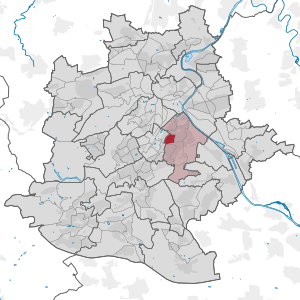Uhlandshöhe
|
Uhlandshöhe district of Stuttgart |
|
|---|---|
| Coordinates | 48 ° 46 '51 " N , 9 ° 11' 40" E |
| surface | 0.41 km² |
| Residents | 2542 (May 31, 2020) |
| Population density | 6200 inhabitants / km² |
| Post Code | 70188 |
| prefix | 0711 |
| Borough | Stuttgart-East |
| Source: Data Compass Stuttgart (PDF; 4.15 MB) | |
The Uhlandshöhe in Stuttgart is an elevation on the eastern edge of the city center that is part of the historic landmarks of Stuttgart. The name of the hill was originally Ameisenberg, but in 1862 the name of a park was transferred to the entire area. With the districts of Gaisburg , Berg , Gablenberg , Ostheim , Frauenkopf , Stöckach and Gänsheide , it has formed the inner district of Stuttgart-East since 2001 .
The Uhlandshöhe borders in the north and east on Ostheim , in the south on Gablenberg , Gänsheide and Diemershalde, in the west on the Kernerviertel. The summit has a height of 355.4 m above sea level. NHN .
The Uhlandshöhe u. a. by
- the Stuttgart observatory , established in 1922 by the association “Schwäbische Sternwarte e. V. ", next to the municipal waterworks from 1893,
- the large Uhlandshöhe park , created in 1862 by the Stuttgart Beautification Association , which, along with the palace gardens and Karlshöhe, is one of the few larger green spaces in the city center. The bronze bust of the poet Ludwig Uhland has stood here since 1955 , designed by the Biberach sculptor Ernst Rau in 1865 and cast by Wilhelm Pelargus ,
- the Free Waldorf School Uhlandshöhe is the very first Waldorf school . It was opened on September 7, 1919. The founder was Emil Molt , the director of the Waldorf-Astoria cigarette factory, who wanted to give the children of his workers a twelve-year education. The head of this factory school was Rudolf Steiner , the founder of anthroposophy,
- the house of the Alemannia Stuttgart fraternity , the oldest fraternity in the area,
- the primary and secondary school Ameisenbergschule .
- At the head of both the Uhlandshöhe and the Gänsheide lies the Villa (Regina) Hauff , built in 1904 for the manufacturer Friedrich Hauff , as a striking representative of the turn from the dogmatic-historical style architecture to a more picturesque-romanticizing style assembly that began at the end of the century. The villa was designed by the architects Karl Hengerer and is now used as a workshop and youth center in Stuttgart (East). It was previously a temporary SS base during wartime and then a US consulate. A turret was attached to the property and still exists today as a vantage point on the Uhlandshöhe.


